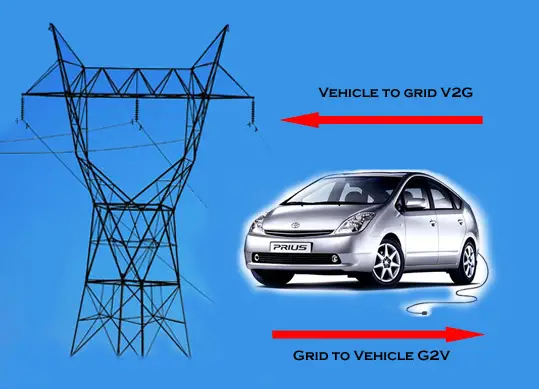The vehicle to grid (V2G) idea is both incredibly simple and hugely complex. Electrically driven vehicles currently being developed have the power to generate clean, 50-60 Hertz Alternating Current at power levels ranging from 10kW in the case of the Honda Insight to 100kW for GM’s old EV1. (Typically a home requires 1kW of power, so one of these vehicles could theoretically power the equivalent of several homes.)
“Combined with smart meters and appropriate control software, Plug in Hybrid Electric Vehicles (PHEV) promises a large, even disruptive impact on electricity supply system. When PHEVsare plugged in, our power can flow both ways: grid to vehicle (G2V) (battery charging) and vehicle to grid (V2G). Even a modest adoption of PHEVs (and electric vehicles like Tesla and the smaller THINK ) over the next few decades represents a vast addition to the amount of electricity potentially available to the electricity grid.
Host buildings, including households, would enjoy the n=benefits of what was in effect an additional power supply to supplement shortcomings in supply from the grid, allowing supply reliability perhaps up to “six nines” (99.9999%), comparable to that available from the most sophisticated uninterruptible power supply systems.

The benefits for the adoption of renewable energy sources, which are fundamentally intermittent in line with their ultimate source, the sun and wind,are also substantial. Solar and wind energy generated surplus to immediate demand can be stored in the batteries of PHEVs plugged into the grid”. (Energy News, Official Journal of The Australian Institute of Energy, Volume 25 Number 4, December 2007, www.aie.org.au )
A Vehicle to Grid study by Kempton, Tomic, Letendre, Brooks & Lipman from the Universities of California, Berkeley and Davis, found that there is very real opportunity in California to provide power to the grid with high-quality electric power from vehicles during times of peak demand. Under this scenario, a participating EV owner could net as much as $3,000 a year in extra income, an amount that could go towards paying for the vehicle.
Of course, there are a number of significant changes which would need to be implemented in terms of technology and policy. Car manufactures, energy utilities, regulators and end users would have to become committed stakeholders in such a far-reaching infrastructure change. In addition to this study, Toyota are considering the possibilities of making use of future electric cars for purposes other than driving. The company suggests that, “it is quite feasible to use the car at home as an emergency electrical power source”.

